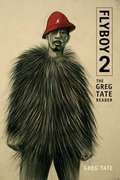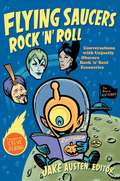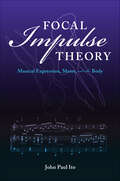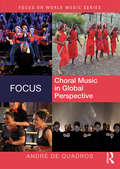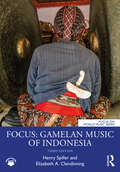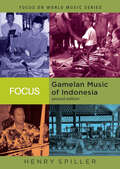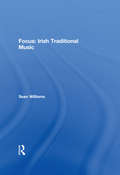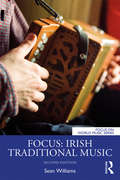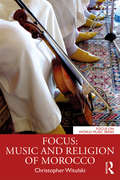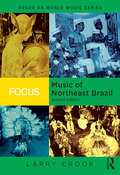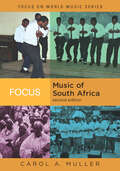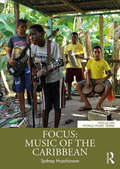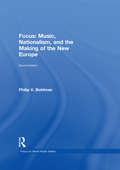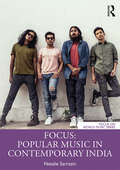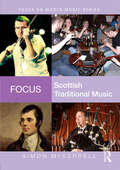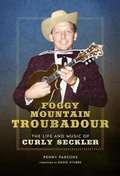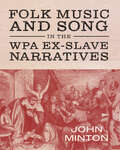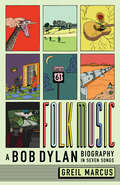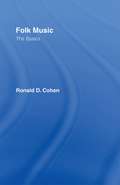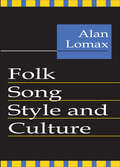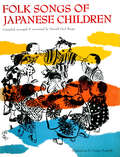- Table View
- List View
Flyboy 2: The Greg Tate Reader
by Greg TateSince launching his career at the Village Voice in the early 1980s Greg Tate has been one of the premiere critical voices on contemporary Black music, art, literature, film, and politics. Flyboy 2 provides a panoramic view of the past thirty years of Tate's influential work. Whether interviewing Miles Davis or Ice Cube, reviewing an Azealia Banks mixtape or Suzan-Lori Parks's Topdog/Underdog, discussing visual artist Kara Walker or writer Clarence Major, or analyzing the ties between Afro-futurism, Black feminism, and social movements, Tate's resounding critical insights illustrate how race, gender, and class become manifest in American popular culture. Above all, Tate demonstrates through his signature mix of vernacular poetics and cultural theory and criticism why visionary Black artists, intellectuals, aesthetics, philosophies, and politics matter to twenty-first-century America.
Flying Saucers Rock 'n' Roll: Conversations with Unjustly Obscure Rock 'n' Soul Eccentrics
by Jake AustenFor nearly twenty years, the much-beloved music magazine Roctober has featured work by some of the best underground cartoonists, exhaustive examinations of made-up genres such as "robot rock," and an ongoing exploration of everything Sammy Davis Jr. ever sang, said, or did. But the heart of the magazine has always been the lengthy conversations with overlooked or forgotten artists. Flying Saucers Rock 'n' Roll gathers the most compelling of these interviews. Eccentric, important artists--including the rockabilly icon Billy Lee Riley, the jazz musician and activist Oscar Brown Jr. , the "Outlaw Country" singer David Allan Coe, and the pioneer rock 'n' roll group the Treniers--give the most in-depth interviews of their lengthy careers. Obscure musicians, such as the Armenian-language novelty artist Guy Chookoorian and the frustrated interstellar glam act Zolar X, reveal fascinating lives lived at rock's margins. Roctober's legendarily dedicated writers convey telling anecdotes in the fervent, captivating prose that has long been appreciated by music enthusiasts. Along with the entertaining interviews, Flying Saucers Rock 'n' Roll features more than sixty images from the pages of Roctober and ten illustrations created for the book by the underground rock 'n' roll artist King Merinuk. Contributors Steve Albini Ben Austen Jake Austen John Battles Bosco Ken Burke Mike Maltese King Merinuk Ken Mottet Jonathan Poletti James Porter "Colonel" Dan Sorenson Jacqueline Stewart
Focal Impulse Theory: Musical Expression, Meter, and the Body (Musical Meaning and Interpretation)
by John Paul ItoMusic is surrounded by movement, from the arching back of the guitarist to the violinist swaying with each bow stroke. To John Paul Ito, these actions are not just a visual display; rather, they reveal what it really means for musicians to move with the beat, organizing the flow of notes from beat to beat and shaping the sound produced. By developing "focal impulse theory," Ito shows how a performer's choices of how to move with the meter can transform the music's expressive contours. Change the dance of the performer's body, and you change the dance of the notes. As Focal Impulse Theory deftly illustrates, bodily movements carry musical meaning and, in a very real sense, are meaning.
Focus: Choral Music in Global Perspective (Focus on World Music Series)
by André de QuadrosFocus: Choral Music in Global Perspective introduces the little-known traditions and repertoires of the world’s choral diversity, from prison choirs in Thailand and gay and lesbian choruses of the Western world to community choruses in the Middle East and youth choirs in the United States. The book weaves together the stories of diverse individuals and organizations, examining their music and pedagogical practices while presenting the author’s research on how choral cultures around the world interact with societies and transform the lives of their members. Through an engaging series of portraits that pushes beyond the scope of extant texts and studies, the author explores the dynamic realm of world choral activity and repertoire. These personal portraits of musical communities are enriched by sample repertoire lists, performance details, and research findings that reposition a once Western phenomenon as a global concept. Focus: Choral Music in Global Perspective is an accessible, engaging, and provocative study of one of the world’s most ubiquitous and socially significant forms of music-making.
Focus: Gamelan Music of Indonesia (Focus on World Music Series)
by Henry Spiller Elizabeth A. ClendinningFocus: Gamelan Music of Indonesia, Third Edition, introduces the emblematic music of Southeast Asia’s largest country, as sound and as cultural phenomenon, highlighting the significant role gamelan music plays in the national culture while teaching of Indonesian values and modern-day life. Despite Indonesia’s great diversity—a melting pot of indigenous, Hindu, Buddhist, Islamic, Portuguese, Dutch, British, and modern global influences—a forged national identity is at its core. This volume explores that identity, understanding present-day Javanese, Balinese, Cirebonese, and Sundanese gamelan music through ethnic, social, cultural, and global perspectives. New to the third edition: Updated content throughout to reflect current Indonesian history and geography, as well as revivals of gamelan ensembles by the Cirebonese courts Modern examples of Indonesian musics, along with new uses of gamelan and other traditional musics An examination of school gamelan and ISBI as a center of innovation Expanded discussion on dangdut and its current status in Indonesia, along with Islam’s effect on dangdut Listening examples now posted as online eResources
Focus: Gamelan Music of Indonesia (Focus on World Music Series)
by Henry SpillerFocus: Gamelan Music of Indonesia is an introduction to the familiar music from Southeast Asia's largest country - both as sound and cultural phenomenon. An archipelago of over 17,000 islands, Indonesia is a melting pot of Hindu, Buddhist, Islamic, Portuguese, Dutch, and British influences. Despite this diversity, it has forged a national culture, one in which music plays a significant role. Gamelan music, in particular, teaches us much about Indonesian values and modern-day life. Focus: Gamelan Music of Indonesia provides an introduction to present-day Javanese, Balinese, Cirebonese, and Sundanese gamelan music through ethnic, social, cultural, and global perspectives. Part One, Music and Southeast Asian History¸ provides introductory materials for the study of Southeast Asian music. Part Two, Gamelan Music in Java and Bali, moves to a more focused overview of Gamelan music in Indonesia. Part Three, Focusing In, takes an in-depth look at Sundanese gamelan traditions, as well modern developments in Sundanese music and dance. The accompanying CD offers vivid examples of traditional Indonesian gamelan music.
Focus: Irish Traditional Music
by Sean WilliamsFocus: Irish Traditional Music is an introduction to the instrumental and vocal traditions of the Republic of Ireland and Northern Ireland, as well as Irish music in the context of the Irish diaspora. Ireland's size relative to Britain or to the mainland of Europe is small, yet its impact on musical traditions beyond its shores has been significant, from the performance of jigs and reels in pub sessions as far-flung as Japan and Cape Town, to the worldwide phenomenon of Riverdance. Focus: Irish Traditional Music interweaves dance, film, language, history, and other interdisciplinary features of Ireland and its diaspora. The accompanying CD presents both traditional and contemporary sounds of Irish music at home and abroad.
Focus: Irish Traditional Music (Focus on World Music Series)
by Sean WilliamsFocus: Irish Traditional Music, Second Edition introduces the instrumental and vocal musics of Ireland, its diaspora in North America, and its Celtic neighbors while exploring the essential values underlying these rich musical cultures and placing them in broader historical and social context. With both the undergraduate and graduate student in mind, the text weaves together past and present, bringing together important ideas about Irish music from a variety of sources and presenting them, in three parts, within interdisciplinary lenses of history, film, politics, poetry, and art: I. Irish Music in Place and Time provides an overview of the island’s musical history and its relationship to current performance practice. II. Music Traditions Abroad and at Home contrasts the instrumental and vocal musics of the "Celtic Nations" (Scotland, Wales, Brittany, etc.) and the United States with those of Ireland. III. Focusing In: Vocal Music in Irish-Gaelic and English identifies the great songs of Ireland’s two main languages and explores the globalization of Irish music. New to this edition are discussions of those contemporary issues reflective of Ireland’s dramatic political and cultural shifts in the decade since first publication, issues concerning equity and inclusion, white nationalism, the Irish Traveller community, hip hop and punk, and more. Pedagogical features—such as discussion questions, a glossary, a timeline of key dates, and expanded references, as well as an online soundtrack—ensure that readers of Focus: Irish Traditional Music, Second Edition will be able to grasp Ireland's important social and cultural contexts and apply that understanding to traditional and contemporary vocal and instrumental music today.
Focus: Music and Religion of Morocco (Focus on World Music Series)
by Christopher WitulskiFocus: Music and Religion of Morocco introduces the region and its history, highlighting how the pressures of religious life, post-colonial economic struggle, and global media come together within Moroccan musical life. Musical practices contextualize and clarify global historical and contemporary movements—many of which remain poorly understood—while articulating the daily realities of the region’s populations in ways that rarely show through current news accounts of religious extremism, poverty and inequality, and forced migration. As with other volumes in the series, Focus: Music and Religion of Morocco addresses large, conceptual issues though interwoven case studies, in three parts: Part I – Memories and Medias: Who We Are highlights how issues of religion, colonialism, nationalism, and globalization transcend boundaries through music to create a sense of personal and national identity, whether hundreds of years ago or on today's satellite television stations. Part II – Contesting Mainstreams: Where We're Going explores Morocco’s sacred and secular music practices as they relate to the country's diversity and its contemporary politics. Part III – Focusing In: Faith and Fun in Fez highlights Fez’s sacred music industry by introducing musicians who navigate musical and religious expectations to appeal to both their own devotional ethics and their audiences’ wants. Links to music examples referenced in the text can be accessed on the eResource site www.routledge.com/9781138094581
Focus: Music in Contemporary Japan (Focus on World Music Series)
by Jennifer Milioto MatsueFocus: Music in Contemporary Japan explores a diversity of musics performed in Japan today, ranging from folk song to classical music, the songs of geisha to the screaming of underground rock, with a specific look at the increasingly popular world of taiko (ensemble drumming). Discussion of contemporary musical practice is situated within broader frames of musical and sociopolitical history, processes of globalization and cosmopolitanism, and the continued search for Japanese identity through artistic expression. It explores how the Japanese have long negotiated cultural identity through musical practice in three parts: Part I, "Japanese Music and Culture," provides an overview of the key characteristics of Japanese culture that inform musical performance, such as the attitude towards the natural environment, changes in ruling powers, dominant religious forms, and historical processes of cultural exchange. Part II, "Sounding Japan," describes the elements that distinguish traditional Japanese music and then explores how music has changed in the modern era under the influence of Western music and ideology. Part III, "Focusing In: Identity, Meaning and Japanese Drumming in Kyoto," is based on fieldwork with musicians and explores the position of Japanese drumming within Kyoto. It focuses on four case studies that paint a vivid picture of each respective site, the music that is practiced, and the pedagogy and creative processes of each group. The accompanying CD includes examples of Japanese music that illustrate specific elements and key genres introduced in the text. A companion website includes additional audio-visual sources discussed in detail in the text. Jennifer Milioto Matsue is an Associate Professor at Union College and specializes in modern Japanese music and culture.
Focus: Music of Northeast Brazil (Focus on World Music Series)
by Larry CrookFocus: Music of Northeast Brazil examines the historical and contemporary manifestations of the music of Brazil, a country with a musical landscape that is layered with complexity and diversity. Based on the author’s field research during the past twenty years, the book describes and analyzes the social/historical contexts and contemporary musical practices of Afro-Brazilian religion, selected Carnival traditions, Bahia’s black cultural renaissance, the traditions of rural migrants, and currents in new popular music. Part One, Understanding Music in Brazil, presents important issues and topics that encompass all of Brazil, and provides a general survey of Brazil’s diverse musical landscape. Part Two, Creating Music in Brazil, presents historical trajectories and contemporary examples of Afro-Brazilian traditions, Carnival music, and northeastern popular music. Part Three, Focusing In, presents two case studies that explore the ground-level activities of contemporary musicians in Northeast Brazil and the ways in which they move between local, national, and international realms. The accompanying CD offers vivid musical examples that are discussed in the text
Focus: Music of South Africa (Focus on World Music Series)
by Carol A. MullerFocus: Music of South Africa provides an in-depth look at the full spectrum of South African music, a musical culture that epitomizes the enormous ethnic, religious, linguistic, class, and gender diversity of the nation itself. Drawing on extensive field and archival research, as well as her own personal experiences, noted ethnomusicologist and South African native Carol A. Muller looks at how South Africans have used music to express a sense of place in South Africa, on the African continent, and around the world. Part One, Creating Connections, provides introductory materials for the study of South African Music. Part Two, Musical Migrations, moves to a more focused overview of significant musical styles in twentieth-century South Africa -- particularly those known through world circuits. Part Three, Focusing In, takes the reader into the heart of two musical cultures with case studies on South African jazz and the music of the Zulu-language followers of Isaiah Shembe. The accompanying CD offers vivid examples of traditional, popular, and classical South African musical styles.
Focus: Music of the Caribbean (Focus on World Music Series)
by Sydney HutchinsonFocus: Music of the Caribbean presents the most important issues of Caribbean musical history and current practice, discussing thought-provoking questions in a student-friendly fashion. It uses current ethnomusicological research on Caribbean music to tell the stories of Caribbean history—those of colonialism and neocolonialism, race and nationalism, marginalization and globalization—and to explore that history’s continuing impact on the lives, cultures, musics, and dance of modern-day people in the Caribbean and beyond. In three parts, the text presents an embodied understanding of the sounds, rhythms, and movements that exemplify the history, culture, and politics of Caribbean music: I. Caribbean Music and Caribbean History establishes a framework for thinking about Caribbean musical history and the roles race and migration play II. Music and Dance in Caribbean Societies considers how contrasting forms of dance music reconcile competing ideas about Caribbean identities past and present III. Focusing In: The Social Lives of Musical Instruments in Merengue Típico explores the music of the Dominican Cibao region through a focus of the genre’s dominant musical instruments Accessible to all students regardless of musical background, Focus: Music of the Caribbean is bolstered by web resources, including more than sixty detailed listening guides and accompanying playlists, vocabulary lists, and student quizzes. Discussion questions and activities for each chapter are featured in the text.
Focus: Music, Nationalism, and the Making of the New Europe (Focus on World Music Series)
by Philip V. BohlmanTwo decades after the fall of communism in Eastern Europe and one decade into the twenty-first century, European music remains one of the most powerful forces for shaping nationalism. Using intensive fieldwork throughout Europe -- from participation in alpine foot pilgrimages to studies of the grandest music spectacle anywhere in the world, the Eurovision Song Contest -- Philip V. Bohlman reveals the ways in which music and nationalism intersect in the shaping of the New Europe. Focus: Music, Nationalism, and the Making of the New Europe begins with the emergence of the European nation-state in the Middle Ages and extends across long periods during which Europe’s nations used music to compete for land and language, and to expand the colonial reach of Europe to the entire world. Bohlman contrasts the "national" and the "nationalist" in music, examining the ways in which their impact on society can be positive and negative -- beneficial for European cultural policy and dangerous in times when many European borders are more fragile than ever. The New Europe of the twenty-first century is more varied, more complex, and more politically volatile than ever, and its music resonates fully with these transformations.
Focus: Popular Music in Contemporary India (Focus on World Music Series)
by Natalie SarrazinFocus: Popular Music in Contemporary India examines India’s musical soundscape beyond the classical and folk traditions of old to consider the culturally, socially, and politically rich contemporary music that is defining and energizing an Indian youth culture on the precipice of a major identity shift. From Bollywood film songs and Indo-jazz to bhangra hip-hop and Indian death metal, the book situates Indian popular music within critical and historical frameworks, highlighting the unprecedented changes the region’s music has undergone in recent decades. This critical approach provides readers with a foundation for understanding an Indian musical culture that is as diverse and complex as the region itself. Included are case studies featuring song notations, first-person narratives, and interviews of well-known artists and emerging musicians alike. Illuminated are issues of great import in India today—as reflected through its music—addressing questions of a "national" aesthetic, the effects of Western music, and identity politics as they relate to class, caste, LGBTQ perspectives, and other marginalized voices. Presented through a global lens, Focus: Popular Music in Contemporary India contextualizes the dynamic popular music of India and its vast cultural impact.
Focus: Scottish Traditional Music (Focus on World Music Series)
by Simon McKerrellFocus: Scottish Traditional Music engages methods from ethnomusicology, popular music studies, cultural studies, and media studies to explain how complex Scottish identities and culture are constructed in the traditional music and culture of Scotland. This book examines Scottish music through their social and performative contexts, outlining vocal traditions such as lullabies, mining songs, Scottish ballads, herding songs, and protest songs as well as instrumental traditions such as fiddle music, country dances, and informal evening pub sessions. Case studies explore the key ideas in understanding Scotland musically by exploring ethnicity, Britishness, belonging, politics, transmission and performance, positioning the cultural identity of Scotland within the United Kingdom. Visit the author's companion website at http://www.scottishtraditionalmusic.org/ for additional resources.
Foggy Mountain Troubadour: The Life and Music of Curly Seckler (Music in American Life)
by Penny ParsonsWith his trademark mandolin style and unequaled tenor harmonies, Curly Seckler has carved out a seventy-seven-year career in bluegrass and country music. His foundational work in Flatt and Scruggs's Foggy Mountain Boys secured him a place in bluegrass history, while his role in The Nashville Grass made him an essential part of the music's triumphant 1970s revival. Written in close collaboration with Mr. Seckler and those who know him, Foggy Mountain Troubadour is the first full-length biography of an American original. Penny Parsons follows a journey from North Carolina schoolhouses to the Grand Ole Opry stage and the Bluegrass Hall of Fame, from boarding houses to radio studios and traveling five to a car on two-lane roads to make the next show. Throughout, she captures the warm humor, hard choices, and vivid details of a brilliant artist's life as he crisscrosses a nation and a century making music.
Folk Music and Song in the WPA Ex-Slave Narratives (American Made Music Series)
by John MintonBetween 1937 and 1940 fieldworkers in the Works Progress Administration’s Federal Writers’ Project interviewed around 3,500 formerly enslaved people in North America, resulting in roughly 20,000 pages of still unedited and inadequately indexed typescript. These accounts—the WPA ex-slave narratives—are the most substantial collection by far of folklore and oral history gathered directly from enslaved people in America. It is arguably the single greatest body of African American folklore extant, and a significant portion is devoted to folk music and song. This book considers this treasure trove in all its relevant social, cultural, and historical contexts. Nineteenth-century Black folk music developed against the backdrop of North American slavery, the American Civil War, Emancipation, the Federal occupation of the South, and a successful white supremacist paramilitary and political insurgency that led to Federal withdrawal, officially sanctioned racial terror, and Southern apartheid. The WPA ex-slave narratives describe that history in remarkable detail. Despite their inestimable value, most of the ex-slave narratives remained unpublished until the late 1970s, being almost unknown except to folklorists. Even after publication, the collection’s sheer size was a barrier. Quoting extensively from the narratives and exhaustively annotated and indexed, this volume provides readers with detailed explanations and full references for every musical item or tradition featured in the ex-slave narratives. John Minton covers instrumental music and social dancing, spirituals and hymns, singing games and lullabies, ring plays and reels, worksongs, minstrel songs, ballads, war songs, slavery laments, and much, much more. Written for both specialists and general readers, with 134 illustrations, the book also offers a general overview of the ex-slave narratives, their contents, creation, and relation to the field of African American folklore as a whole.
Folk Music: A Bob Dylan Biography in Seven Songs
by Greil MarcusAcclaimed cultural critic Greil Marcus tells the story of Bob Dylan through the lens of seven penetrating songs &“Marcus delivers yet another essential work of music journalism.&”—Kirkus Reviews (starred review) &“Just as Dylan allows a song to carry him away, readers will be transported by the sheer poetry of Marcus&’ prose.&”—June Sawyers, Booklist (starred review) &“Further elevates Marcus to what he has always been: a supreme artist-critic.&”—Hilton Als Across seven decades, Bob Dylan has been the first singer of American song. As a writer and performer, he has rewritten the national songbook in a way that comes from his own vision and yet can feel as if it belongs to anyone who might listen. In Folk Music, Greil Marcus tells Dylan&’s story through seven of his most transformative songs. Marcus&’s point of departure is Dylan&’s ability to &“see myself in others.&” Like Dylan&’s songs, this book is a work of implicit patriotism and creative skepticism. It illuminates Dylan&’s continuing presence and relevance through his empathy—his imaginative identification with other people. This is not only a deeply felt telling of the life and times of Bob Dylan but a rich history of American folk songs and the new life they were given as Dylan sat down to write his own.
Folk Music: The Basics (The Basics)
by Ronald CohenFolk Music: The Basics gives a brief introduction to British and American folk music. Drawing upon the most recent and relevant scholarship, it will focus on comparing and contrasting the historical nature of the three aspects of understanding folk music: traditional, local performers; professional collectors; and the advent of professional performers in the twentieth century during the so-called "folk revival." The two sides of the folk tradition will be examined--both as popular and commercial expressions. Folk Music: The Basics serves as an excellent introduction to the players, the music, and the styles that make folk music an enduring and well-loved musical style. Throughout, sidebars offer studies of key folk performers, record labels, and related issues to place the general discussion in context.
Folk Song Style and Culture
by Alan LomaxSong and dance style--viewed as nonverbal communications about culture--are here related to social structure and cultural history. Patterns of performance, theme, text and movement are analyzed in large samples of films an recordings from the whole range of human culture, according to the methods explained in this volume. Cantometrics, which means song as a measure of man, finds that traditions of singing trace the main historic distributions of human culture and that specific traits of performance are communications about identifiable aspects of society. The predictable and universal relations between expressive communication and social organization, here established for the first time, open up the possibility of a scientific aesthetics, useful to planners.
Folk Songs Hawaii Sings
by John M. KellyFolk Songs Hawaii Sings is a sparkling compilation of melodies from the islands of Polynesia together with a variety of folk songs that countless Oriental people have brought with them to their new home in the Hawaiian Islands. In one sense it is a musical picture of the renowned harmonious blend of people who reside in Hawaii today; in another, it is a colorful record of ties with the Eastern world and ancestral heritage in line with the same American tradition that saw songs of the soil and the sea brought to the United States from Europe in an earlier age.All the songs and more, whether from Hawaii or Samoa, China or Japan, the Philippines, Okinawa, or Mongolia, are melodic bearers of traditions and aspirations, or vehicles of simple pleasures that form the background of the people who today share the hospitable sun of the Hawaiian Islands with their Caucasian neighbors. These melodies and rhythms have found their way into the many festivals and musical presentations that are so much a way of life in the welcome addition to the American Union.
Folk Songs Hawaii Sings
by John M. KellyFolk Songs Hawaii Sings is a sparkling compilation of melodies from the islands of Polynesia together with a variety of folk songs that countless Asian people have brought with them to their new home in the Hawaiian Islands.In one sense it is a musical picture of the renowned harmonious blend of people who reside in Hawaii today; in another, it is a colorful record of ties with the Eastern world and ancestral heritage in line with the same American tradition that saw songs of the soil and the sea brought to the United States from Europe in an earlier age.All the songs and more, whether from Hawaii or Samoa, China or Japan, the Philippines, Okinawa, or Mongolia, are melodic bearers of traditions and aspirations, or vehicles of simple pleasures that form the background of the people who today share the hospitable sun of the Hawaiian Islands with their Caucasian neighbors. These melodies and rhythms have found their way into the many festivals and musical presentations that are so much a way of life in the welcome addition to the American Union.
Folk Songs of Japanese Children
by Yoshie Noguchi Donald Paul BergerSimple, singable, and engaging, the traditional songs of Japanese children combine the unique charm of Japan with the universal appeal of children's music everywhere. Some of the fifteen songs in this collection are current throughout Japan. Others are little known outside a small area. All have deep roots in history and tradition. Several are game songs that will be enjoyed by all children who have played "London Bridge is Falling Down" or "The Farmer in the Dell." Mr. Berger's commentary on each song illuminates many facets of Japanese culture; and his arrangements, with easy piano accompaniments, make the songs suitable for unison or two-part singing by children or adults. The complete Japanese text, in both Japanese characters and Roman alphabet, is included for each song, together with a singable English version and a literal translation.
Folk Songs of Japanese Children
by Yoshie Noguchi Donald Paul BergerThis is a delightful collection of Japanese children's songs with lyrics, sheet music and cultural notes.Simple, singable, and engaging, the traditional songs of Japanese children combine the unique charm of Japan with the universal appeal of children's music everywhere. Some of the fifteen songs in this collection are current throughout Japan. Others are little known outside a small area. All have deep roots in history and tradition. Several are game songs that will be enjoyed by all children who have played "London Bridge is Falling Down" or "The Farmer in the Dell."Mr. Berger's commentary on each song illuminates many facets of Japanese culture; and his arrangements, with easy piano accompaniments, make the songs suitable for unison or two-part singing by children or adults. The complete Japanese text, in both Japanese characters and Roman alphabet, is included for each song, together with a singable English version and a literal translation.
